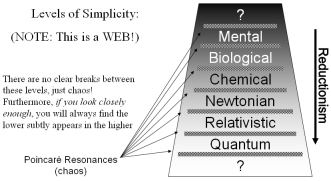If you know of a power rule not on this list, email me at webmaster2 <at symbol> nedprod. You'll need to provide me with at least one academic paper detailing the rule even if that paper isn't actually the original paper but rather a subsequent paper.
Where do these rules come from?
They come from the underlying fractal nature of the universe, which emerges from the chaotic attractors generated by the system of interconnections that is the universe no matter at what level you are looking at it. Depending on the form of the underlying fractal, you may get a certain guaranteed structure right across it that holds no matter what.
From Biology:
| Description | Rule | Notes | Reference |
|---|---|---|---|
| Group Size for Primates | N = 100.093 x CR 3.389 | N is group number, CR is the neocortex ratio (as against rest of brain size), = 4.1 for humans | Dunbar, R.I.M. (1998). The Social Brain Hypothesis |
| Whole Organism Metabolic Rate | B = B0 x M 3/4 | M is mass, B0 is a scaling constant, = 5.66 for higher primates | Peters, R.H. (1983). The Ecological
Implications of Body Size. Cambridge University Press, Cambridge. Moses, M.E. and Brown, J.H. (2003). Allometry of human fertility and energy use |
| Heart Rate, Reproduction Rate, Cellular Metabolic Rate | R ~ M -1/4 R ~ B -1/3 |
M is mass, B is whole organism metabolic rate | |
| Plant Growth Rate | G ~ V p | G is annual increment, V is living tissue tree volume, p is less than one |
Applications of Fractals to Biology
From Linguistics:
| Description | Rule | Notes | Reference |
|---|---|---|---|
| The Growth of Vocabulary against Text Size | V = K x N b | V is the portion of vocabulary, K is a scaling factor between 10 and 100, N is the number of words in the text and b for English language is between 0.4 and 0.6 | Heap's Law |
From Physics:
There are loads of these in physics, but here are an example two:
| Description | Rule | Notes | Reference |
|---|---|---|---|
| Gravitation | F = -6.67 x 10-11 x M x R-2 | F is force, M the combined mass, R the distance between masses | |
| Electrostatic | F = 8,987,742,438 x Q x R-2 | F is force, Q the combined charge, R the distance between charges |
Links:
http://www.nslij-genetics.org/wli/zipf/index.html has a small list of power rules
